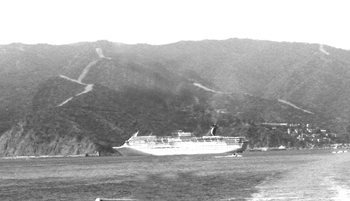![[Metroactive News&Issues]](/gifs/news468.gif)
[ Santa Cruz Week | SantaCruz Home | Archives ]
Even when the cruise industry plays by the rules, critics say its effects on our waters can be nasty business
By Rebecca Patt
Most of us would think that common sense is enough to prevent the dumping of oil, sewage, garbage and toxic chemicals such as heavy metals, turpentine and perchloroethylene (dry cleaning sludge) into the sea. Yet because of negligence and lax regulations, cruise ships have done it again and again. An international law makes it illegal to dispose of plastic and oil anywhere at sea, but otherwise, cruise ships can legally dump almost anything, writes Ross Klein in his book Cruise Ship Blues. This waste--even the legal stuff--can be devastating to marine life.
Oil is one of the biggest concerns. Even in small amounts, ingestion of oil can be highly toxic to birds, marine mammals and fish. It can also coat their fur and feathers and interfere with their ability to insulate themselves, says Kaitlin Gaffney, program manager at the Ocean Conservancy.
Sewage is also a huge hazard. It introduces disease-causing microorganisms and excessive nutrients. The pathogens can become concentrated in the tissues of shellfish and other filter feeders, making them unsafe for human consumption, writes Klein. Pathogens also harm coral and the nutrients in sewage promotes excessive growth of algae, which suffocates fish. If the sewage is released close to shore, it can result in sick surfers and beach closures. The Clean Water Act generally prohibits the dumping of sewage within three miles of shore, but beyond that, cruise ships can dump their toilets into the sea.
Hazardous waste from dry cleaning, photo processing, X-ray fluids, paint solvents, fluorescent light bulbs and batteries can harm or kill marine life and in turn threaten the humans who consume it. And garbage and plastic is not only ugly on the beaches, it can also be swallowed by animals that, for instance, confuse plastic bags with jellyfish. Turtles and birds are especially susceptible.
The EPA has found that even gray water--the water from the sinks, the showers and the galley--is potentially hazardous. Yet the Clean Water Act permits it to be legally dumped anywhere except the Great Lakes and certain parts of Alaska's Inside Passage, writes Klein.
Not only do cruise ships' wastes have the potential to cause great harm to marine life, but the ships themselves have been known to fatally strike whales. On July 16, 2001, a dead pregnant humpback whale known as "Whale Number 68" was found floating dead near the entrance to Glacier Bay in Alaska. The cause of death was determined to be collision with a cruise ship.
Copyright © Metro Publishing Inc. Maintained by Boulevards New Media.
![]()

Built to Spill
From the January 15-21, 2003 issue of Metro Santa Cruz.